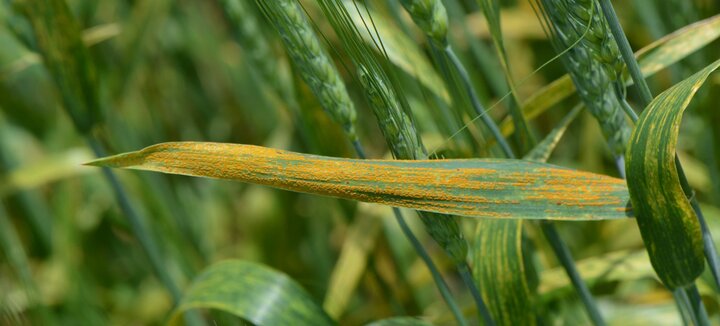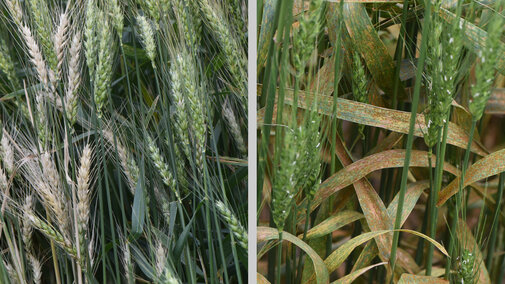Prolonged cool weather in spring delayed the onset of wheat diseases during the 2019 growing season in Nebraska. The major diseases that developed starting in late spring were Fusarium head blight (scab, Figure 1), leaf rust (Figure 2), stripe rust (Figure 3), and bacterial streak (Figure 4). Other diseases that occurred included leaf spot diseases (tan spot and Septoria tritici blotch), powdery mildew, and take-all. Although not observed at damaging levels in 2019, diseases affecting the grain such as common bunt (stinking smut) and loose smut and virus diseases such as wheat streak mosaic can occur and cause significant losses during any growing season. This article summarizes strategies that can be used this fall to minimize losses during next year’s growing season.
1. Use certified, fungicide-treated seed.



Fungicide seed treatments reduce losses caused by seed-transmitted and soilborne fungal diseases of wheat. Some seed treatment products contain a fungicide and an insecticide and offer additional protection against fall diseases and insects such as aphids that can be disease vectors.
Seedborne diseases controlled by fungicide seed treatments include common bunt (also known as stinking smut) and loose smut, which replace the grain on the wheat head. Flag smut, which can prevent export of wheat grain to certain countries, can be effectively controlled with fungicide seed treatments. Other seedborne diseases do not affect the wheat head, but cause seedling blights and root and crown rots. They include Fusarium head blight and black point. Soilborne diseases controlled by fungicide seed treatments include Rhizoctonia and Pythium root rots, common root rot, and Fusarium root and crown rots.
This year it is especially important to use certified, fungicide-treated seed because many wheat fields in eastern, south central, and southwest Nebraska were affected by Fusarium head blight, resulting in scabby grain that, if untreated and used as seed, can result in severe damping off and seedling blight. For more information see this June 25 CropWatch article: Strategies for Handling Wheat Grain Affected by Fusarium Head Blight.
2. Control volunteer wheat and grassy weeds before planting.
Volunteer wheat, especially that which emerges before harvest as a result of a hailstorm, poses a high risk for wheat streak mosaic and other wheat curl mite transmitted virus diseases of wheat (Triticum mosaic and High Plains disease). This is because the volunteer wheat serves as a host for wheat curl mites and the viruses during the period between harvest and planting in the fall. If the volunteer wheat is not controlled before planting, the mites move from it to the fall-planted wheat and transmit the viruses, resulting in severe losses the following growing season. The mites also can survive on grassy weeds. Volunteer wheat and grassy weeds should be controlled so that they are completely dead at least two weeks before planting.
3. Plant at the recommended date for your area.
Planting winter wheat too early lengthens the time when environmental conditions (warm temperatures and moisture) are favorable for development of fall season diseases such as wheat streak mosaic, barley yellow dwarf, and leaf rust. Wheat curl mites and insect vectors of diseases, for example aphids, have more time to transmit diseases if wheat is planted too early. Planting too late gives little time for wheat to establish itself before cold winter temperatures set in. This can result in weak plants that are vulnerable to attack by diseases in the spring. Therefore, it is recommended that winter wheat be planted at the recommended date for the respective wheat growing regions in the state (Figure 5).
4. Consider disease resistance levels when selecting varieties.
Some wheat varieties have good levels of resistance to certain diseases. Select varieties that have a good disease resistance package. Disease resistance information can be found in the Fall Seed Guide. Fusarium head blight ratings from the 2019 state variety trials in Saunders, Lancaster, and Jefferson counties in southeast Nebraska are shown in Table 1. Leaf rust ratings from the 2019 state variety trials in Saunders and Lancaster counties are shown in Table 2. Leaf rust ratings in a 2018 state variety trial in Keith County in west central Nebraska are provided in Table 3.
5. Plant several varieties that differ in their genetics.
Because of genetic differences, wheat varieties will react differently to diseases and some varieties will mature sooner or later than others. Planting several varieties with different genetic backgrounds is a strategy that can reduce losses due to diseases. For example, if only one variety is planted and it happens to be susceptible to a predominant disease during the growing season, yield loss can be much greater than if two or three varieties were planted that have different levels of resistance. Because there is only a short window (flowering) when the Fusarium head blight fungus infects wheat, if two or three varieties differing in flowering dates are planted, the probability that one or two of the varieties will escape heavy infections increases.
6. Use an integrated approach to manage wheat diseases.
Integrating all or most of the disease management strategies available to you is the most effective approach to reduce losses in winter wheat. This fall use as many of the strategies outlined here to minimize losses during the next growing season.
| Entry* | Rating** | |||
|---|---|---|---|---|
| Saunders Co | Lancaster Co | Jefferson Co | Avg | |
| 17-Jun | 14-Jun | 16-Jun | ||
| Overland | 3 | 3 | 3 | 3 |
| WB4699 | 3 | 4 | 3 | 3 |
| Turkey | 3 | 4 | 3 | 3 |
| SY Benefit | 5 | 3 | 3 | 4 |
| NE14538 | 4 | 4 | 5 | 4 |
| Zenda | 5 | 4 | 5 | 5 |
| WB4269 | 6 | 6 | 4 | 5 |
| NE10478-1 | 5 | 6 | 5 | 5 |
| NW13493 | 5 | 6 | 6 | 6 |
| Freeman | 6 | 7 | 6 | 6 |
| Scout 66 | 6 | 6 | 6 | 6 |
| NE14434 | 7 | 6 | 7 | 7 |
| WB4418 | 8 | 7 | 7 | 7 |
| Long Branch | 8 | 7 | 6 | 7 |
| SY Wolf | 7 | 8 | 8 | 8 |
| NE12561 | 9 | 8 | 8 | 8 |
| WB4303 | 9 | 7 | 9 | 8 |
| Ruth | 8 | 8 | 9 | 8 |
| SY Monument | 8 | 9 | 9 | 9 |
| AM Eastwood | 8 | 9 | 9 | 9 |
| Matterhorn | 9 | 9 | 9 | 9 |
| Mattern | 9 | 9 | 9 | 9 |
| NHH144913-3 | 9 | 9 | 9 | 9 |
| WB Grainfield | 9 | 9 | 9 | 9 |
|
* Average of five replications at each location. |
||||
| Entry* | Rating** | ||
|---|---|---|---|
| Saunders Co | Lancaster Co | Avg | |
| 17-Jun | 14-Jun | ||
| WB4699 | 1 | 1 | 1 |
| WB4303 | 1 | 2 | 1 |
| SY Wolf | 2 | 2 | 2 |
| Zenda | 2 | 2 | 2 |
| NW13493 | 3 | 2 | 2 |
| WB4418 | 2 | 2 | 2 |
| SY Monument | 2 | 2 | 2 |
| NHH144913-3 | 3 | 3 | 3 |
| WB4269 | 3 | 3 | 3 |
| NE14538 | 3 | 3 | 3 |
| NE10478-1 | 3 | 3 | 3 |
| NE14434 | 3 | 3 | 3 |
| Overland | 3 | 4 | 3 |
| NE12561 | 3 | 5 | 4 |
| Long Branch | 6 | 5 | 6 |
| Freeman | 6 | 5 | 6 |
| Matterhorn | 7 | 7 | 7 |
| Turkey | 6 | 8 | 7 |
| AM Eastwood | 8 | 8 | 8 |
| Scout 66 | 8 | 8 | 8 |
| Mattern | 8 | 9 | 8 |
| WB Grainfield | 9 | 9 | 9 |
| Ruth | 9 | 9 | 9 |
| SY Benefit | 9 | 9 | 9 |
| * Average of five replications at each location. ** 1-9 Rating Scale, 1 = Resistant; 9 = Susceptible |
|||
| Entry* | Rating** |
|---|---|
| SYWolf | 1 |
| Oakley CL | 1 |
| CROPLAN EXP 56-17 | 2 |
| LCS Chrome | 2 |
| NHH144913-3 | 3 |
| NW13493 | 3 |
| NE13604 | 3 |
| SY Rugged | 3 |
| SY Monument | 3 |
| NE14434 | 3 |
| Overland | 3 |
| WB4418 | 3 |
| NW13570 | 4 |
| WB4721 | 4 |
| LCH14-55 | 4 |
| NE12561 | 5 |
| LCH14-77 | 5 |
| Infinity CL | 6 |
| Mace | 6 |
| CROPLAN EXP 69-16 | 6 |
| WB4462 | 6 |
| NE13515 | 6 |
| Freeman | 6 |
| LCS Link | 7 |
| NE104781 | 7 |
| SY Sunrise | 7 |
| Turkey | 7 |
| CO13D1783 | 8 |
| NI13706 | 8 |
| 07CL046-2 | 8 |
| Scout 66 | 8 |
| SY Flint | 8 |
| Long Branch | 8 |
| WB-Grainfield | 9 |
| Winterhawk | 9 |
| Ruth | 9 |
| Langin | 9 |
| Robidoux | 9 |
| AM Eastwood | 9 |
| WB4458 | 9 |
| LCS Mint | 9 |
| Tatanka | 9 |
| T158 | 9 |
| CROPLAN EXP 27-17 | 9 |
| Wesley | 9 |
| Settler CL | 9 |
|
* Average of five replications. |
|

